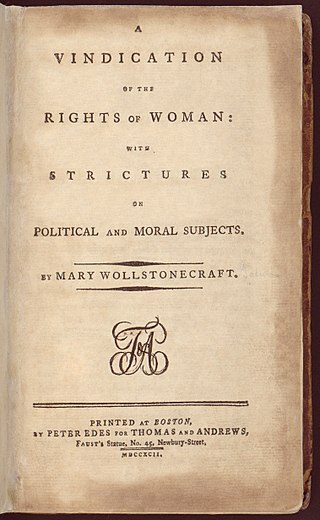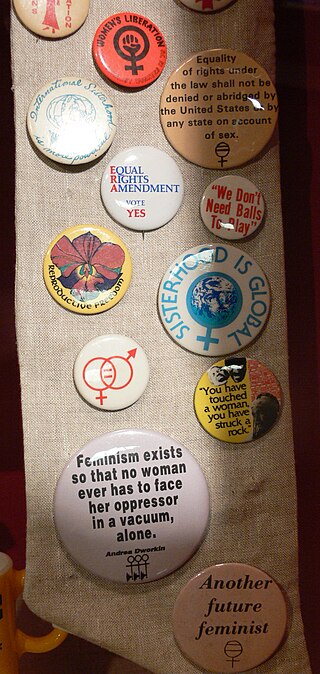
A Vindication of the Rights of Woman: with Strictures on Political and Moral Subjects (1792), written by British philosopher and women's rights advocate Mary Wollstonecraft (1759–1797), is one of the earliest works of feminist philosophy. In it, Wollstonecraft responds to those educational and political theorists of the eighteenth century who did not believe women should receive a rational education. She argues that women ought to have an education commensurate with their position in society, claiming that women are essential to the nation because they educate its children and because they could be "companions" to their husbands, rather than mere wives. Instead of viewing women as ornaments to society or property to be traded in marriage, Wollstonecraft maintains that they are human beings deserving of the same fundamental rights as men.
Feminism is a range of socio-political movements and ideologies that aim to define and establish the political, economic, personal, and social equality of the sexes. Feminism holds the position that societies prioritize the male point of view and that women are treated unjustly in these societies. Efforts to change this include fighting against gender stereotypes and improving educational, professional, and interpersonal opportunities and outcomes for women.

Matriarchy is a social system in which women hold the primary power positions in roles of authority. In a broader sense it can also extend to moral authority, social privilege and control of property. While those definitions apply in general English, definitions specific to anthropology and feminism differ in some respects.
Liberal feminism, also called mainstream feminism, is a main branch of feminism defined by its focus on achieving gender equality through political and legal reform within the framework of liberal democracy and informed by a human rights perspective. It is often considered culturally progressive and economically center-right to center-left. As the oldest of the "Big Three" schools of feminist thought, liberal feminism has its roots in 19th century first-wave feminism seeking recognition of women as equal citizens, focusing particularly on women's suffrage and access to education, the effort associated with 19th century liberalism and progressivism. Liberal feminism "works within the structure of mainstream society to integrate women into that structure." Liberal feminism places great emphasis on the public world, especially laws, political institutions, education and working life, and considers the denial of equal legal and political rights as the main obstacle to equality. As such liberal feminists have worked to bring women into the political mainstream. Liberal feminism is inclusive and socially progressive, while broadly supporting existing institutions of power in liberal democratic societies, and is associated with centrism and reformism. Liberal feminism tends to be adopted by white middle-class women who do not disagree with the current social structure; Zhang and Rios found that liberal feminism with its focus on equality is viewed as the dominant and "default" form of feminism. Liberal feminism actively supports men's involvement in feminism and both women and men have always been active participants in the movement; progressive men had an important role alongside women in the struggle for equal political rights since the movement was launched in the 19th century.
Equality feminism is a subset of the overall feminism movement and more specifically of the liberal feminist tradition that focuses on the basic similarities between men and women, and whose ultimate goal is the equality of all genders in all domains. This includes economic and political equality, equal access within the workplace, freedom from oppressive gender stereotyping, and an androgynous worldview.
This is an index of articles related to the issue of feminism, women's liberation, the women's movement, and women's rights.
The history of feminism comprises the narratives of the movements and ideologies which have aimed at equal rights for women. While feminists around the world have differed in causes, goals, and intentions depending on time, culture, and country, most Western feminist historians assert that all movements that work to obtain women's rights should be considered feminist movements, even when they did not apply the term to themselves. Some other historians limit the term "feminist" to the modern feminist movement and its progeny, and use the label "protofeminist" to describe earlier movements.
Second-wave feminism was a period of feminist activity that began in the early 1960s and lasted roughly two decades before ushering in a third wave of feminism beginning in the early 1990s. It took place throughout the Western world, and aimed to increase equality for women by building on previous feminist gains in the late 19th and early 20th centuries.
First-wave feminism was a period of feminist activity and thought that occurred during the 19th and early 20th century throughout the Western world. It focused on legal issues, primarily on securing women's right to vote. The term is often used synonymously with the kind of feminism espoused by the liberal women's rights movement with roots in the first wave, with organizations such as the International Alliance of Women and its affiliates. This feminist movement still focuses on equality from a mainly legal perspective.

The Declaration of the Rights of Woman and of the Female Citizen, also known as the Declaration of the Rights of Woman, was written on 14 September 1791 by French activist, feminist, and playwright Olympe de Gouges in response to the 1789 Declaration of the Rights of Man and of the Citizen. By publishing this document on 15 September, de Gouges hoped to expose the failures of the French Revolution in the recognition of gender equality. As a result of her writings, de Gouges was accused, tried and convicted of treason, resulting in her immediate execution, along with the Girondists, becoming one of only three women beheaded during the ensuing Reign of Terror – and the only executed for her political writings.
Antifeminism, also spelled anti-feminism, is opposition to some or all forms of feminism. In the late 19th century and early 20th century, antifeminists opposed particular policy proposals for women's rights, such as the right to vote, educational opportunities, property rights, and access to birth control. In the mid and late 20th century, antifeminists often opposed the abortion-rights movement and, in the United States, the Equal Rights Amendment.
The men's movement is a social movement that emerged in the 1960s and 1970s, primarily in Western countries, which consists of groups and organizations of men and their allies who focus on gender issues and whose activities range from self-help and support to lobbying and activism.
Equity feminism is a form of liberal feminism that advocates the state's equal treatment of women and men without challenging inequalities perpetuated by employers, educational and religious institutions, and other elements of society. The concept has been discussed since the 1980s. Equity feminism has been defined and classified as a kind of classically liberal or libertarian feminism, in contrast with social feminism, difference feminism, gender feminism, and equality feminism.
Some variants of feminism are considered more conservative than others. Historically feminist scholars tend to not have much interest in conservative women but in recent years there have been efforts at greater scholarly analysis of these women and their views.

A variety of movements of feminist ideology have developed over the years. They vary in goals, strategies, and affiliations. They often overlap, and some feminists identify themselves with several branches of feminist thought.
Feminist political theory is an area of philosophy that focuses on understanding and critiquing the way political philosophy is usually construed and on articulating how political theory might be reconstructed in a way that advances feminist concerns. Feminist political theory combines aspects of both feminist theory and political theory in order to take a feminist approach to traditional questions within political philosophy.

The feminist movement, also known as the women's movement, refers to a series of social movements and political campaigns for radical and liberal reforms on women's issues created by the inequality between men and women. Such issues are women's liberation, reproductive rights, domestic violence, maternity leave, equal pay, women's suffrage, sexual harassment, and sexual violence. The movement's priorities have expanded since its beginning in the 1800s, and vary among nations and communities. Priorities range from opposition to female genital mutilation in one country, to opposition to the glass ceiling in another.
The following is a timeline of the history of feminism.

Maternal feminism is the belief of many early feminists that women as mothers and caregivers had an important but distinctive role to play in society and in politics. It incorporates reform ideas from social feminism, and combines the concepts of maternalism and feminism. It was a widespread philosophy among well-to-do women in the British Empire, particularly Canada, from the late 19th century until after World War I (1914–18). The concept was attacked by later feminists as accepting the paternalist view of society and providing an excuse for inequality.
Labor feminism was a women's movement in the United States that emerged in the 1920s, focused on gaining rights in the workplace and unions. Labor feminists advocated for protectionist legislation and special benefits for women, a variant of social feminism. They helped pass state laws regulating working conditions for women, expanded women's participation in unions, and organized to oppose the Equal Rights Amendment.






